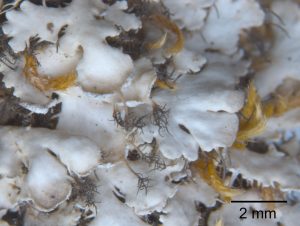Heterodermia
Heterodermia Trevis., 1868
| Common name | Centipede Lichens |
 |
|---|---|---|
| Field Characters | Small to medium sized leafy chlorolichens. Pale, loosely appressed to ascending thalli with lobes that often broaden near the lobe tips. Heterodermia gets its name from its unusual cortical tissues. The hyphae are aligned parallel to the lobe, giving the upper cortex a “combed” or “flowing” appearance. Besides being finely striate, the upper cortex is typically dull, milky white to greenish white to browned. The lower cortex is white or in some species absent. Soralia are common and the placement can be used to distinguish species, varing from marginal to terminal in hooded or labriform lobe tips. Apothecia rare in Alberta species, common in some species elsewhere. The margins are commonly ciliate (but sometimes the cilia are referred to as rhizines, depending on the author). The important thing is that these cilia vary from simple to squarrose branched to thyrisiform (branching three or more times) and those differences are important taxonomically. These are the structures that give these species the common name of Centipede Lichens. There is still more to learned about the taxonomy of this species in Alberta, and if in doubt, don’t limit yourself to these species, see Lendemer 2009. | |
| Similar species & genera |
Anaptychia: while this genus also has a combed upper cortex, its species are brown to grey-brown, the lobes typically are < 1 mm wide, the thalli are more loosely attached and appear almost fruticose. Thalli typically are extensively ciliate.
Physcia: no flow to upper cortex, rarely ciliate |
|
| Ecology | Mostly epiphytic, some saxicolous. Occasional across the boreal region, rare in other forested ecoregions. | |
| Chemistry | Upper cortex K+yellow, PD- or PD+ pale yellow, KC-, C-, UV- (atranorin). Medulla with various compounds including norstictic acid, zeorin, or salazinic acid. | |
| Molecular support |
Mixed, but more work is in progress. Heterodermia as traditionally conceived is apparently not monophyletic (Mongkolsuk et al. 2015), but we are waiting to adopt new nomenclature pending the work of Esslinger and Leavitt on the Physciaceae of North America. | |
| Links |
Species recorded in Alberta: 3, but H. speciosa has not been confirmed with recent collections and may be a misidentification, and we haven’t formally reported H. galactophylla.
- H. galactophylla (Tuck.) W. L. Culb.. Syns.: Anaptychia comosa (for North American records), A. galactophylla (Currently not on ACIMS list but confirmed by James Lendemer)
- H. japonica (M. Satô) Swinscow & Krog (Currently not on ACIMS list but confirmed by James Lendemer; this species is currently under Polyblastidium japonica in CLH)
- H. speciosa (Wulfen) Trevisan Syns.: Anaptychia pseudospeciosa var. tremulans, A. speciosa (ACIMS, ABMI)
DICHOTOMOUS KEY: Heterodermia & Anaptychia
Modified and simplified from Lendemer 2009, and based on redeterminatikon of PMAE material and observations of Alberta material. *All of the species in this key are clearly foliose, closely attached to the surface, lack any orange or yellow pigments on the underside, and are sorediate. Any specimens not fitting this description should be keyed with Lendemer 2009. TLC can also be helpful as H. galactophylla and H. japonica appear to have their own chemical profiles.
1a. Lobes < 1 mm wide, often browned, almost fruticose, extensively ciliate, esorediate; rare in Alberta…..Anaptychia crinalis
1b. Lobes on average > 1mm wide, clearly foliose…..2
2a. Soralia terminal and labriform…..3
2b. Soralia marginal; rhizines squarrose…..4
3a. Epiphytic; soralia strongly reflexed, wider than the width of the lobe bearing the soralium; soredia powdery; cilia branching ≥3 times )thyrisiform), pale near attachment point and darkening distally; Alberta’s most common Heterodermia…..Heterodermia galactophylla
3b. Saxicolous or terricolous; pruinose; soralia in mostly terminal and weakly labriform soralia the same width as lobe; soredia granular, often darkening; rhizines simple to forked…..Anaptychia elbursiana
4a. Underside corticate at least in part (examine lobes away from the lobe tips, towards the centre of the thallus); rare in Alberta…..Heterodermia speciosa
4b. Underside ecorticate and unpigmented; soralia marginal and terminal…..Heterodermia japonica
RENR Students: Know Heterodermia galactophylla– be able to key this species out or recognize it. Note that the two most common Alberta species, H. galactophylla & H. japonica are not covered in Brodo et al. 2001 or Goward et al. 1994.
Resources
Brodo, I. M. 2016. Keys to the lichens of North America. Revised and Expanded. Yale University Press, in collaboration with the Canadian Museum of Nature.
Brodo, I. M., S. D. Sharnoff, and S. Sharnoff. 2001. Lichens of North America. Yale University Press, New Haven and London.
Goward, T., B. McCune, and D. Meidinger. 1994. The Lichens of British Columbia Illustrated Keys. Part 1 – Foliose and Squamulose Species. Ministry of Forests Research Program, Province of British Columbia.
Lendemer, J. C. 2009. A synopsis of the lichen genus of Heterodermia (Physciaceae, lichenized Ascomycota) in eastern North America. Opuscula Philolichenum 6.
Lücking, R., R. del Prado, H. T. Lumbsch, S. Will-Wolf, A. Aptroot, H. J. M. Sipman, L. Umana & J. L. Chaves. 2008. Phylogenetic pattersn of morphological and chemical characters and reproductive mode in the Heterodermia obscurata group in Costa Rica (Ascomycota, Physciaceae). Systematics and Biodiversity 6: 31-41.
Mongkolsuk, P., S. Meesim, V. Poengsungnoen, K. Buaruang, F. Schumm & K. Kalb. 2015. The lichen family Physciaceae in Thailand—II. Contributions to the genus Heterodermia sensu lato. Phytotaxa 235: 1-66.

